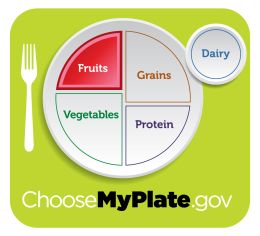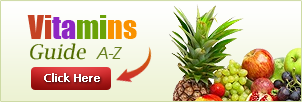Fruit Food Group
- Fruit Food Group
- Dairy Food Group
- Grain Food Group
- Vegetable Food Group
- Protein Food Group
- Oils
- Empty Calories
- Physical Activity
MyPlate – Fruit Food Group
The red section of USDA’s MyPlate illustrates the fruit food group. Make sure that half of your plate has fruits and vegetables. Fruits offer nutrients vital for a healthy and well maintained body. Those who eat more fruits and vegetables as a part of a balanced and healthy diet are more likely to reduce risks of many chronic conditions and diseases.

What counts as part of the Fruit Food Group?
Any fruit or 100% fruit juice is a part of the fruit group. You can choose fresh, frozen, dried or canned fruit, but you should go easy on the fruit juice. There are a number of foods in the fruit group to include:
- Apples, apricots, bananas
- Strawberries, raspberries, blueberries
- Oranges, nectarines, peaches, pears, plums, prunes
- Cherries, grapefruit, kiwi fruit, lemons, limes
- Cantaloupe, watermelon, honeydew
- 100% Fruit juices – grapefruit, apple, grape, orange
How much is needed from the Fruit Food Group?
The amount of fruit each person needs is contingent upon their level of regular physical activity, age and gender. As a benchmark, an adult woman needs about 1.5-2 cups of fruits every day, and a man needs about 2 cups. What is important to remember is to make half your plate fruits and vegetables, and that will almost assuredly ensure that you are taken in enough fruits and vegetables on a daily basis.
What counts as a cup?
More times than not, fruit measurements are required in cups. One cup of fruit, ½ cup dried fruit, or 100% fruit juice can be considered as a cup within the fruit group.
In other words:
- 1 cup from the fruit group = 1 cup of fruit or
- 1 cup from the fruit group = 1 cup of 100% fruit juice or
- 1 cup from the fruit group = ½ cup of dried fruit
Why is it important to eat fruit?
Fruit provides you with vital nutrients such as dietary fiber, potassium, vitamin C, and folate (folic acid) that are often underconsumed. A well balanced diet rich in fruits and vegetables provides many health benefits, such as reducing the risk of certain chronic diseases. Some of the health benefits associated with eating fruit include:
- The possibility of reducing conditions such as stroke, heart disease and heart attack.
- Possible protection against certain types of cancer.
- Rich fiber diets from fruits and vegetables may reduce the risk of obesity, type 2 diabetes and heart disease.
- Eating fruits and vegetables that are high in potassium as part of a balanced diet may lower blood pressure, and may reduce the risk of developing bone loss and kidney stones.
- Eating lower calorie fruits per cup instead of those that may be higher in calories may help to reduce overall caloric intake.
5 Tips to Eat More Fruit
The USDA offers many tips on how to increase your daily fruit intake. Here are a few that may help you:
- Keep a bowl of fresh fruit on the counter, table or in the refrigerator that is readily accessible to all family members.
- Buy fruit when it is in season because they will be less expensive and will be at peak taste.
- Make sure to stack up on dried, frozen and canned fruits.
- Consider convenience when you shop and try to select pre-packaged or already prepared fruit. The lack of having to do something to it, and the ease with which you can access it may increase your willingness to take it home from the store and eat it. If the fruit is already prepared then you may be more willing to snack on it, and incorporate it into your daily meal planning.
- A bowl of fruit makes a lovely decoration. You will be tempted to eat more fruit just by looking at the tasty and colorful colors.
There are a few recipes that can also help to increase your daily fruit intake. Here’s an example, and more can be found at the MyPlate website.
Cucumber Yogurt Dip
Ingredients:
2 cups plan low fat yogurt
2 large cucumbers
½ cup non fat sour cream
Tablespoon of lemon juice
Tablespoon of fresh dill
1 chopped clove of garlic
1 cup of cherry tomatoes
1 cup broccoli – preferably florets
1 cup carrots
Preparation:
Seed, peel and grate the cucumbers. Slice them and set aside
Mix grated cucumbers, yogurt lemon juice, dill, garlic and sour cream in a serving bowl and chill for an hour.
Arrange tomatoes, broccoli, and carrots on a plate or platter and serve with dip.
Reference:
USDA’s MyPlate

 Facebook
Facebook  Twitter
Twitter  RSS
RSS







